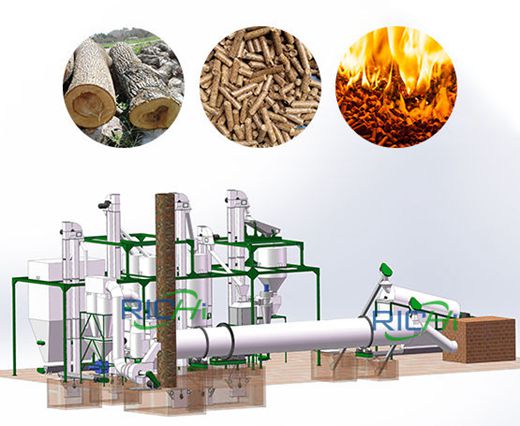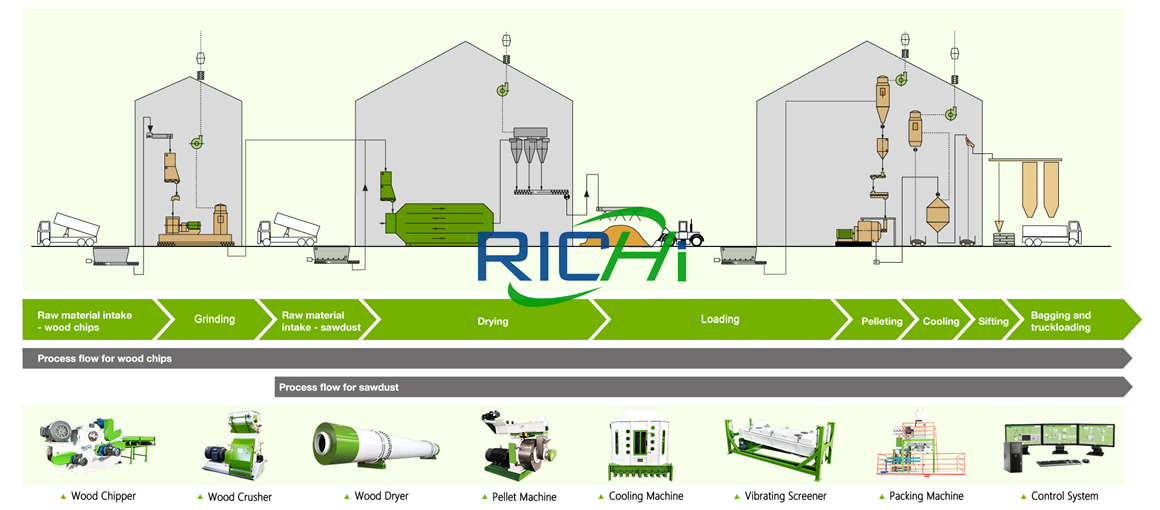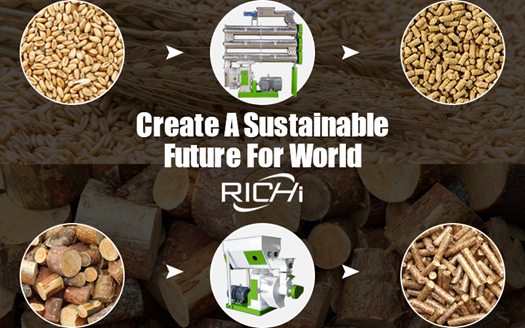Wood pellet processing plant
Contents |
[edit] Introduction
Wood pellet plants combine the complete procedure of biomass particle production, including all processes from drying out to squashing, granulation, cooling, testing and packaging. Plant may be arranged or customised in a variety of ways according to need as well as the degree of automation in cooling, packaging, and feeding.
[edit] Process
Appropriate raw materials are selected for natural fibres such as logs, branches, sawdust, rice husks, etc. These enter by conveyor belt and are sent to the wood hammer mill. On leaving in a crushed form these are directly send onward by the screw conveyor. This leads into the drum, similar to a clothes dryer, where materials are mixed with hot air. The dried material is accumulated by a cyclone separator, and then exits from the bottom of the airlock.
The next stage is the conditioner which is entered again via the screw conveyor, this conditions the material to the ideal level. Once achieving the intended moisture level the material is sent to the pelletising chamber, this performs a granulation process, with the material exiting as small round pellets of 2-12mm. The pellets then enter the cooler, drying the pellets to below 10%, and also cooling them to a regular temperature.
The remaining powder passes through the rotary category screener, which can separate out unqualified materials and granulate these once again. The screened pellets are loaded by an automated weighing device and then sealed by an automatic stitching device.
The complete set that makes up a wood pellet plant is not just timber pellet production equipment, it also a variety other treatment equipment according to the sort of resources and humidity.
If the raw materials arrives in larger sizes such as whole branches, it needs to be crushed into timber chips less than 5mm by a separate crusher, if it arrives smaller it can enter directly. If the humidity of the raw material is 15%-20%, it can enter the device directly, if it is higher than 20%, it has to be dried to 15-20% prior to granulation.
[edit] Renewable
As a renewable fuel, timber pellets have several advantages, such as high calorific worth, reduced emissions, huge particle proportion or compression after moulding, small volume, and combustion resistance. They have a higher level of processing than wood chips but due to their form can often be used more easily in small and large automated heaters, from industry to individual homes as an alternative fuel. Wood pellets can also utilise wood waste from saw mills and carpentry workshops.
Making use of wood pellets as a fuel is a realistic alternative environmental power resource that can help reduce carbon emissions, and has been used both in rural and urban locations.
[edit] Related articles on Designing Buildings
Featured articles and news
CIOB report; a blueprint for SDGs and the built environment
Pairing the Sustainable Development Goals with projects.
Latest Build UK Building Safety Regime explainer published
Key elements in one short, now updated document.
UKGBC launch the UK Climate Resilience Roadmap
First guidance of its kind on direct climate impacts for the built environment and how it can adapt.
CLC Health, Safety and Wellbeing Strategy 2025
Launched by the Minister for Industry to look at fatalities on site, improving mental health and other issues.
One of the most impressive Victorian architects. Book review.
Common Assessment Standard now with building safety
New CAS update now includes mandatory building safety questions.
RTPI leader to become new CIOB Chief Executive Officer
Dr Victoria Hills MRTPI, FICE to take over after Caroline Gumble’s departure.
Social and affordable housing, a long term plan for delivery
The “Delivering a Decade of Renewal for Social and Affordable Housing” strategy sets out future path.
A change to adoptive architecture
Effects of global weather warming on architectural detailing, material choice and human interaction.
The proposed publicly owned and backed subsidiary of Homes England, to facilitate new homes.
How big is the problem and what can we do to mitigate the effects?
Overheating guidance and tools for building designers
A number of cool guides to help with the heat.
The UK's Modern Industrial Strategy: A 10 year plan
Previous consultation criticism, current key elements and general support with some persisting reservations.
Building Safety Regulator reforms
New roles, new staff and a new fast track service pave the way for a single construction regulator.
Architectural Technologist CPDs and Communications
CIAT CPD… and how you can do it!
Cooling centres and cool spaces
Managing extreme heat in cities by directing the public to places for heat stress relief and water sources.
Winter gardens: A brief history and warm variations
Extending the season with glass in different forms and terms.
Restoring Great Yarmouth's Winter Gardens
Transforming one of the least sustainable constructions imaginable.


























